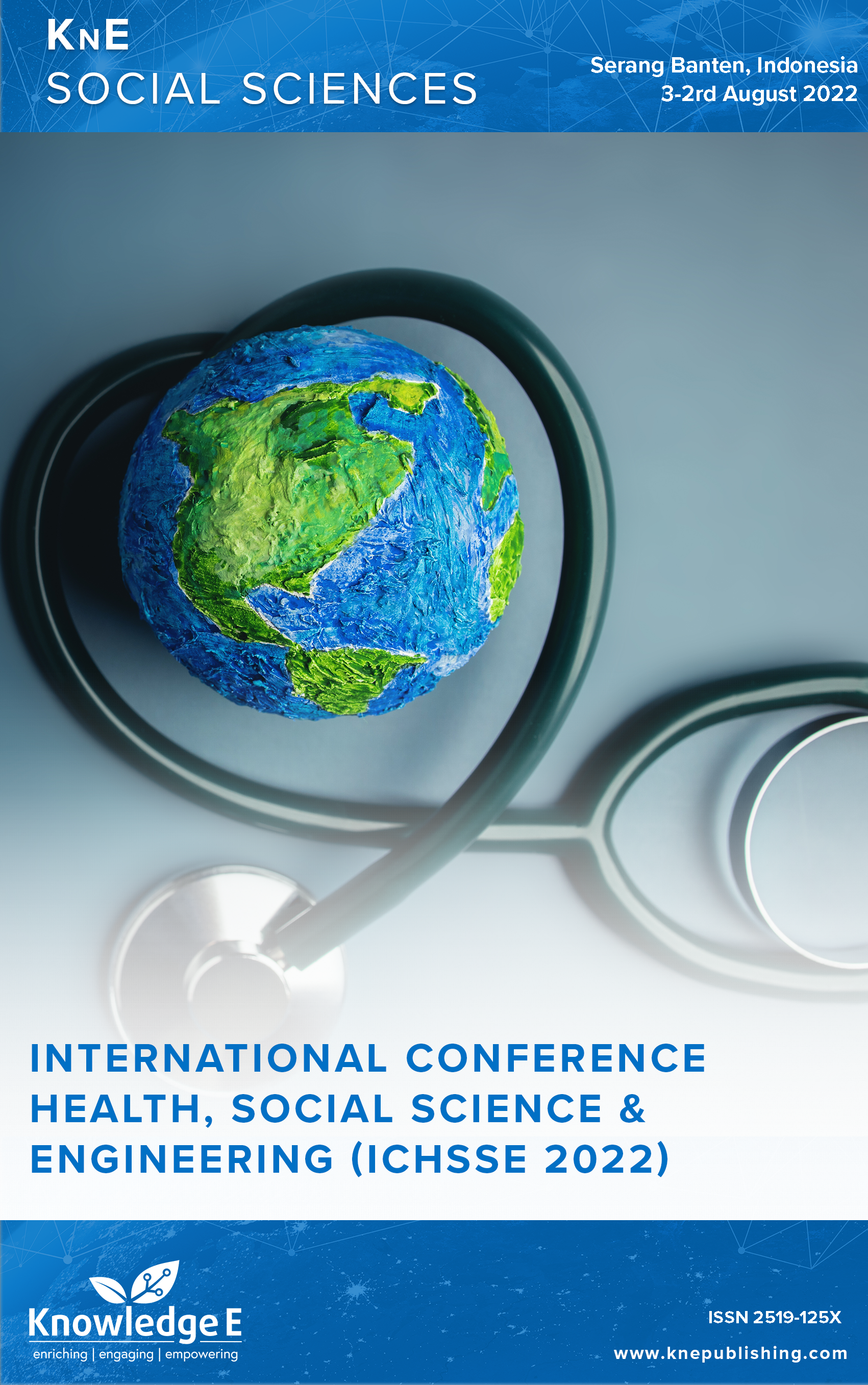The Association Between Family Supports and Middle Adult Hypertension Prevention Behavior
DOI:
https://doi.org/10.18502/kss.v8i14.13831Abstract
One of the leading causes of death worldwide is hypertension. Indonesia still has a very low level of hypertension prevention awareness. Support from the family can help people prevent hypertension. Family support is a type of interpersonal interaction that involves accepting family members and having positive views toward them, so that they feel cared for. An action taken to avoid hypertension is called a hypertension preventative habit. This study aims to examine how family support and hypertension prevention behavior relate to one another in middle adulthood in the Baros ward, which is the service area for the Baros Public Health Center in Sukabumi City. This study has a cross-sectional design and is a correlational investigation. Cluster random sampling was used to collect data from 116 respondents in 8 hamlets in the Baros district. Collecting data using a questionnaire and bivariate analysis with Chi-square. The results of this study were 88 (75, 9%) respondents were known to have family support and as many as 67 respondents (76,1%) had good behavior in preventing hypertension. The results of Chi-square test showed p-value = 0.000 (< 0.05) indicating a connection between family support and hypertension prevention behavior in middle adulthood and it is hoped that this research will be an input for improving outreach programs about the importance of family support for hypertension prevention behavior.
Keywords: family support, behavior, hypertension
References
[2] Kruk ME, Gage AD, Arsenault C, Jordan K, Leslie HH, Roder-DeWan S, et al. High-quality health systems in the Sustainable Development Goals era: Time for a revolution. Lancet Glob Health. 2018;6(11):e1196–e1252.
[3] Whitworth JA, Chalmers J. World Health Organisation-International Society of Hypertension (WHO/ISH) hypertension guidelines. Clin Exp Hypertens. 2004;26(7– 8):747–752.
[4] Roesmono B, Hamsah H, Irwan I. Hubungan Perilaku Mengontrol Tekanan Darah Dengan Kejadian Hipertensi. JIKP Jurnal Ilmiah Kesehatan Pencerah. 2017;6(2):70– 75.
[5] Notoatmodjo S. Metodologi Penelitian Kesehatan, Rineka Cipta. Jakarta Indonesia. 2010.
[6] Firmansyah RS, Lukman M, Mambangsari CW. Faktor-faktor yang berhubungan dengan dukungan keluarga dalam pencegahan primer hipertensi. Jurnal Keperawatan Padjadjaran. 2017;5(2).
[7] Rahmah S. Hubungan Pengetahuan, Sikap Dan Dukungan Keluarga Dengan Keaktifan Kontrol Penderita Hipertensi Di Puskesmas Durian Gantang Kabupaten Hulu Sungai Tengah. Hipertensi. 2019.
[8] Dewi KCC, Prapti NKG, Saputra IK. Hubungan dukungan keluarga dengan tingkat kepatuhan penatalaksanaan diet lansia dengan hipertensi di lingkungan Kelurahan Tonja. Coping: Community of Publishing in Nursing. 2016;4(1).
[9] Tumenggung I. Hubungan dukungan sosial keluarga dengan kepatuhan diet pasien hipertensi di RSUD Toto Kabila Kabupaten Bone Bolango. J Health Sport. 2013;7(01).
[10] Utari M. Dukungan Keluarga tentang Kepatuhan Diet Hipertensi pada Lansia Di Puskesmas Pembantu Kelurahan Persiakan Tebing Tinggi. 2017.
[11] Notoatmodjo S. Metodologi Penelitian Kesehatan, Jakarta, PT Rineka Cipta. Profil SMA. 2012;(2).
[12] Friedman MM, Bowden VR, Jones EG. Buku Ajar Keoerawatan Keluarga (Riset, teori, dan praktik) Edisi 5. Jakarta: EGC; 2014.
[13] Azwar S. Reliabilitas dan validitas. Yogyakarta: pustaka pelajar. 2012.
[14] Sarafino EP, Smith TW. Health psychology: Biopsychosocial interactions. John Wiley & Sons; 2014.
[15] Chusmeywati V. Kualitas Hidup Penderita Diabetes Melitus Di Rs PKU Muhammadiyah Yogyakarta unit II. Jurnal Fakultas Kedokteran Dan Ilmu Kesehatan Muhammadiyah Yogyakarta. 2016.
[16] Susriyanti S. Pengaruh Kepemimpinan Transformasional Dan Motivasi Kerja Terhadap Kinerja Karyawan Pada PT. BPR Mitra Danagung. Jurnal Ekonomi. 2014;15(1):81–107.
[17] Ecobici M, Stoicescu C. Arterial stiffness and hypertension–which comes first? Maedica (Bucur). 2017;12(3):184.
[18] Weber MA. Recently published hypertension guidelines of the JNC 8 panelists, the American Society of Hypertension/International Society of Hypertension and other major organizations: Introduction to a focus issue of the Journal of Clinical Hypertension. J Clin Hypertens (Greenwich). 2014 Apr;16(4):241-245.
[19] Zafar SN, Gowani SA, Irani FA, Ishaq M. Awareness of the risk factors, presenting features and complications of hypertension amongst hypertensives and normotensives. J Pak Med Assoc. 2008 Dec;58(12):711–715.
[20] Sarafino EP, Smith TW. Health psychology: Biopsychosocial interactions, 7th edition. Amerika Serikat: Wiley; 2011.
[21] Yudasmara K. Hipertensi dalam kehamilan. www.balipost.com. 2010.
[22] Notoatmodjo. Health research methods. Jakarta: Rineka Cipta; 2018.
[23] Smeltzer SC, Bare BG. Keperawatan Medikal Bedah (Handbook for Brunner & Suddarth’s Textbook of Medical-Surgical Nursing). Jakarta: EGC; 2015.
[24] Ojo OS, Malomo SO, Sogunle PT. Blood pressure (BP) control and perceived family support in patients with essential hypertension seen at a primary care clinic in Western Nigeria. J Family Med Prim Care. 2016;5(3):569.
[25] Oparil S, Acelajado MC, Bakris GL, Berlowitz DR, Cífková R, Dominiczak AF, et al. Hypertension. Nat Rev Dis Primers. 2018 Mar;4:18014.
[26] Nuridah N, Yodang Y. Pengaruh Terapi Bekam terhadap Tekanan Darah pada Penderita Hipertensi: Studi Quasy Eksperimental. Jurnal Kesehatan Vokasional. 2021;6(1):53–60.
[27] Cornelissen VA, Fagard RH. Effects of endurance training on blood pressure, blood pressure-regulating mechanisms, and cardiovascular risk factors. Hypertension. 2005 Oct;46(4):667–675.

